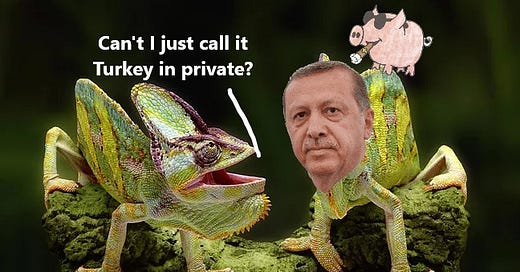Ottoman Dreams, Syrian Nightmares, and the Triangle Wars, Part 3
Loving would be easy if your colors were like my dreams
This note was sent to institutional clients on 5 June 2021. The likely expansion of Turkish military activity in northern Syria and possibly a large-scale move into northern Iraq are moving the Levant back onto the priority list of global affairs. By hook or by crook, Turkey must solve its energy deficit problem and the eastern Med or Iraqi Kurdistan are his last best options.
The push and pull of Turkish politics mirror the push and pull of Turkey’s dueling expansionist identities. Erdoğan has been working tirelessly to create a Turkish-Islamic synthesis so that he can side-step that issue and unite all of Turkey’s expansionists.
As an Islamist, Erdoğan’s natural inclination was to look southwards, which encompasses the core of the Islamic world and – not coincidentally – overlaps heavily with the Ottoman Empire’s footprint.
Uniting Turkish expansionists under one banner is proving more difficult than Erdoğan appears to have expected. He must walk the fine line of not being “too nationalist” or “too Islamist” because neither side of his coalition is comfortable with the other – even though they both adore him.
The Two Triangles
In Part 1 of this series, I discussed the constant drag energy imports exert on Turkey’s current account. Bereft of domestic energy resources, Turkey is forced to rely on imports for ninety-nine percent of its oil and natural gas consumption. The continual need for dollars to fund energy imports is a problem because Turkey has no major export industries to bring in dollars. To pay for energy imports and access global capital markets Turkey needs a reliable source of dollars.
In Part 2, I discussed Erdoğan’s efforts to solve his dollar deficit problem by positioning Turkey as an energy hub linking Asia and Europe. Turkey sits at the meeting point of two “energy triangles” (Map A). These triangles include not only the energy resources, but also the key trade routes needed to bring the oil and natural gas to market. Indeed, the trade routes being fought over by nations today are the same fought over by kings and pharaohs millennia ago. (Map B).
The northern triangle, pictured in red, includes the energy resources of Central Asia and the transport route that runs through the Caucuses and across the Black Sea. The southern triangle, pictured in green, includes the Middle East and the transport route that runs through the Persian Gulf to the Red Sea and through the Suez. This note focuses on the domestic political factors behind Erdogan’s strategy in the Triangle Wars.
Keep reading with a 7-day free trial
Subscribe to Capitalist Pig Collective to keep reading this post and get 7 days of free access to the full post archives.






